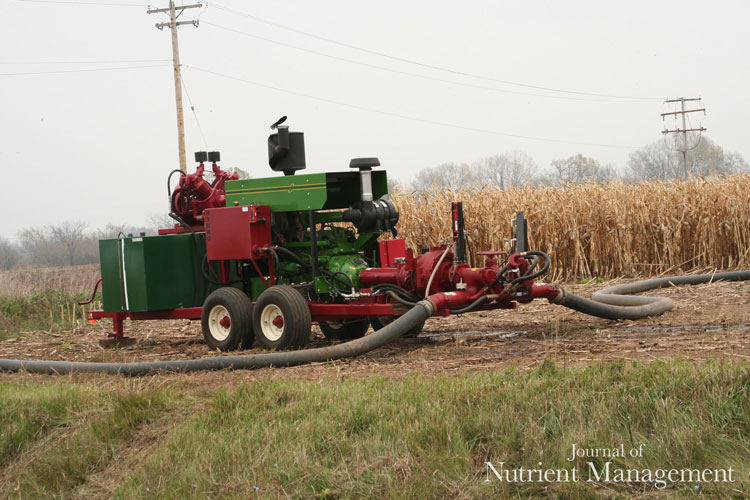
Many farms depend on professional manure applicators to deliver important nutrients to the field. As an example, the for-hire manure application industry serving Wisconsin handles approximately 7 billion gallons of liquid manure annually. That’s enough manure to cover a football field, including end zones, just over 3 miles deep. And while the percentage of manure handled by the industry hasn’t changed much over the past decade, the equipment used is constantly evolving.
Switching to more big rigs
The annual directory of manure applicators, compiled by the University of Wisconsin–Madison Division of Extension since 2003, includes information about the equipment used by more than 200 for-hire manure applicators. These businesses range from a single truck or manure spreader to larger application firms that handle more than 300 million gallons annually.
The most obvious trends over the past 20 years are the rising number of semis used to move manure, and, more recently, the dramatic shift to technologies that use less fuel and/or are more labor efficient. This change was forced by the challenges of finding high-quality seasonal employees.
Since 2003, the number of semis used to move manure from the farm to the field has risen from 68 to 637, with growth propelled by both the need to move manure longer distances and the adoption of roadside manure transfer systems. Moving manure by semi is more time and cost efficient for greater distances. It is preferred by livestock producers because roadside transfer systems, which avoid vehicles entering and leaving the field, do not track mud or manure onto the road, improving safety and reducing neighbor concerns.
The challenge of finding qualified commercial drivers license (CDL) drivers has led to a dramatic shift in the trend since 2020, with many manure applicators shifting from employing in-house drivers to using owner/operators who move from job to job, either with their own semi and tanker or who rent a tanker from farmers or other manure applicators. Between 2021 and 2022, the number of owner/operators in Wisconsin jumped from fewer than 10 to 60, while semis and tankers operated by manure applicators dropped for the first time. This approach means that drivers move between forage, manure, grain, and non-ag loads weekly, if not daily. If it rains too much on one side of a county, for instance, these more nimble operators can quickly adjust and assist livestock producers, forage operations, and manure applicators where it did not rain as much.
More hose, less diesel
Many of the semis are used for roadside transfer systems, with one or more manure tankers or dragline systems applying in the field. The total miles of mainline hose has leveled off at just over 350 miles in the state, but the diameter of the hose used has expanded dramatically. In 2014, around 75% of the manure hose in use was 6-inch, while 25% of hoses were 8 or 10-inch. In 2022, only 15% of the hose was 6-inch, with 226 miles of 8-inch diameter hose (64% of the total) in use.
A larger hose means less diesel per gallon of manure moved because the larger diameter reduces friction loss. Higher volumes per minute through the hose result in the ability to cover more acres per hour, sometimes by being able to feed two different crews with 6-inch lines from a single 8-inch main.
Diesel fuel savings are one reason manure agitation boats have grown in popularity in Wisconsin from seven in 2011 to 113 in 2022. The combination of fuel savings (60% to 80% compared to tractor-mounted agitators) and the ability to agitate larger storages more efficiently have reduced costs both for applicators and the livestock producers providing fuel for the manure storage agitation.
Some tools lag behind
The data also shows a much slower adoption rate for technologies that do not have the labor savings or fuel savings. This includes low disturbance toolbars and real time nutrient sensors.
Low-disturbance injection toolbars on both dragline systems and manure tankers can dramatically reduce soil erosion and make it easier for livestock producers and farmers who take manure and sell feed to livestock farms to meet conservation compliance requirements. After a quick doubling of the toolbars in use from 2017 to 2020, numbers have now leveled off. Part of the reason may be the lower application rate chosen by many livestock producers, which reduces the number of acres that manure can be applied to in a day.
Another technology with lower than expected adoption by the for-hire manure application industry in Wisconsin is real-time nutrient sensors. These sensors measure nitrogen (N), phosphorus (P), potassium (K), and dry matter and allow the manure applicator to vary the rate based on the nutrient content of the manure. Interest and adoption of the technology has been greater in states with more swine manure, where the cash grain farmer receives manure based payments for the manure on the nutrient value. Varying the rate can mean avoiding a second trip across the field to apply fertilizer in more highly productive portions of the field.
Adoption rates of technologies that benefit both the manure applicator and the farmer equally tend to be more in the middle. In 2022, 76% of the manure applicators with dragline systems offered GPS as-applied rate mapping to their customers. As-applied mapping provides both the applicator and livestock producer with documentation that their manure was applied at the right rate in the right location. Hopefully, technology such as this will become more mainstream over time.
This article appeared in the November 2023 issue of Journal of Nutrient Management on pages 22-23. Not a subscriber? Click to get the print magazine.




